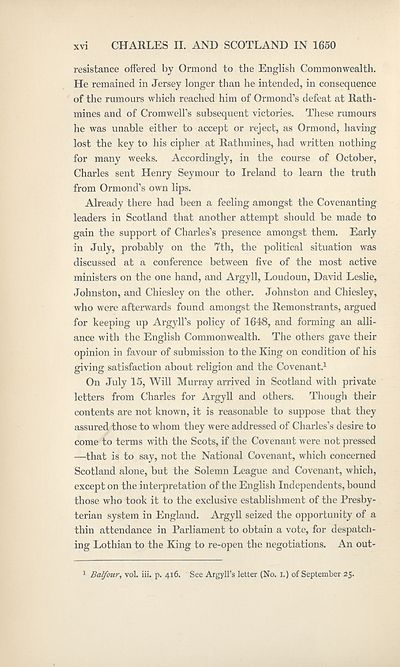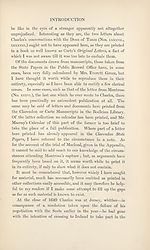Series 1 > Letters and papers illustrating the relations between Charles the Second and Scotland in 1650
(21) Page xvi
Download files
Complete book:
Individual page:
Thumbnail gallery: Grid view | List view

xvi CHARLES II. AND SCOTLAND IN 1650
resistance offered by Ormond to the English Commonwealth.
He remained in Jersey longer than he intended, in consequence
of the rumours which reached him of Ormond’s defeat at Rath-
mines and of Cromwell’s subsequent victories. These rumours
he was unable either to accept or reject, as Ormond, having
lost the key to his cipher at Rathmines, had written nothing
for many weeks. Accordingly, in the course of October,
Charles sent Henry Seymour to Ireland to learn the truth
from Ormond’s own lips.
Already there had been a feeling amongst the Covenanting
leaders in Scotland that another attempt should be made to
gain the support of Charles’s presence amongst them. Early
in July, probably on the 7th, the political situation was
discussed at a conference between five of the most active
ministers on the one hand, and Argyll, Loudoun, David Leslie,
Johnston, and Chiesley on the other. Johnston and Chiesley,
who were afterwards found amongst the Remonstrants, argued
for keeping up Argyll’s policy of 1648, and forming an alli¬
ance with the English Commonwealth. The others gave their
opinion in favour of submission to the King on condition of his
giving satisfaction about religion and the Covenant.1
On July 15, Will Murray arrived in Scotland with private
letters from Charles for Argyll and others. Though their
contents are not known, it is reasonable to suppose that they
assured those to whom they were addressed of Charles’s desire to
come to terms with the Scots, if the Covenant were not pressed
—that is to say, not the National Covenant, which concerned
Scotland alone, but the Solemn League and Covenant, which,
except on the interpretation of the English Independents, bound
those who took it to the exclusive establishment of the Presby¬
terian system in England. Argyll seized the opportunity of a
thin attendance in Parliament to obtain a vote, for despatch¬
ing Lothian to the King to re-open the negotiations. An out-
1 Balfour, vol. iii. p. 416. See Argyll’s letter (No. I.) of September 25.
resistance offered by Ormond to the English Commonwealth.
He remained in Jersey longer than he intended, in consequence
of the rumours which reached him of Ormond’s defeat at Rath-
mines and of Cromwell’s subsequent victories. These rumours
he was unable either to accept or reject, as Ormond, having
lost the key to his cipher at Rathmines, had written nothing
for many weeks. Accordingly, in the course of October,
Charles sent Henry Seymour to Ireland to learn the truth
from Ormond’s own lips.
Already there had been a feeling amongst the Covenanting
leaders in Scotland that another attempt should be made to
gain the support of Charles’s presence amongst them. Early
in July, probably on the 7th, the political situation was
discussed at a conference between five of the most active
ministers on the one hand, and Argyll, Loudoun, David Leslie,
Johnston, and Chiesley on the other. Johnston and Chiesley,
who were afterwards found amongst the Remonstrants, argued
for keeping up Argyll’s policy of 1648, and forming an alli¬
ance with the English Commonwealth. The others gave their
opinion in favour of submission to the King on condition of his
giving satisfaction about religion and the Covenant.1
On July 15, Will Murray arrived in Scotland with private
letters from Charles for Argyll and others. Though their
contents are not known, it is reasonable to suppose that they
assured those to whom they were addressed of Charles’s desire to
come to terms with the Scots, if the Covenant were not pressed
—that is to say, not the National Covenant, which concerned
Scotland alone, but the Solemn League and Covenant, which,
except on the interpretation of the English Independents, bound
those who took it to the exclusive establishment of the Presby¬
terian system in England. Argyll seized the opportunity of a
thin attendance in Parliament to obtain a vote, for despatch¬
ing Lothian to the King to re-open the negotiations. An out-
1 Balfour, vol. iii. p. 416. See Argyll’s letter (No. I.) of September 25.
Set display mode to:
![]() Universal Viewer |
Universal Viewer | ![]() Mirador |
Large image | Transcription
Mirador |
Large image | Transcription
Images and transcriptions on this page, including medium image downloads, may be used under the Creative Commons Attribution 4.0 International Licence unless otherwise stated. ![]()
| Scottish History Society volumes > Series 1 > Letters and papers illustrating the relations between Charles the Second and Scotland in 1650 > (21) Page xvi |
|---|
| Permanent URL | https://digital.nls.uk/127070745 |
|---|
| Attribution and copyright: |
|
|---|
| Description | Over 180 volumes, published by the Scottish History Society, containing original sources on Scotland's history and people. With a wide range of subjects, the books collectively cover all periods from the 12th to 20th centuries, and reflect changing trends in Scottish history. Sources are accompanied by scholarly interpretation, references and bibliographies. Volumes are usually published annually, and more digitised volumes will be added as they become available. |
|---|


